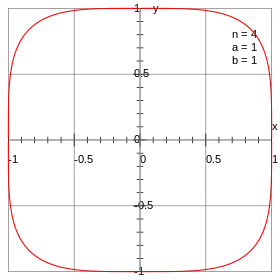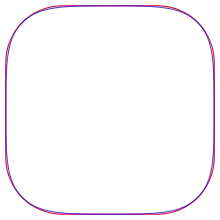
A squircle is a shape intermediate between a square and a circle. There are at least two definitions of "squircle" in use, the most common of which is based on the superellipse. The word "squircle" is a portmanteau of the words "square" and "circle". Squircles have been applied in design and optics.
Superellipse-based squircle
In a Cartesian coordinate system, the superellipse is defined by the equation
where ra and rb are the semi-major and semi-minor axes, a and b are the x and y coordinates of the centre of the ellipse, and n is a positive number. The squircle is then defined as the superellipse with ra = rb and n = 4. Its equation is:[1]
where r is the minor radius of the squircle. Compare this to the equation of a circle. When the squircle is centred at the origin, then a = b = 0, and it is called Lamé's special quartic.
The area inside the squircle can be expressed in terms of the gamma function Γ as[1]
where r is the minor radius of the squircle, and is the lemniscate constant.
p-norm notation
In terms of the p-norm ‖ · ‖p on R2, the squircle can be expressed as:
where p = 4, xc = (a, b) is the vector denoting the centre of the squircle, and x = (x, y). Effectively, this is still a "circle" of points at a distance r from the centre, but distance is defined differently. For comparison, the usual circle is the case p = 2, whereas the square is given by the p → ∞ case (the supremum norm), and a rotated square is given by p = 1 (the taxicab norm). This allows a straightforward generalization to a spherical cube, or sphube, in R3, or hypersphube in higher dimensions.[2]
Fernández-Guasti squircle
Another squircle comes from work in optics.[3][4] It may be called the Fernández-Guasti squircle, after one of its authors, to distinguish it from the superellipse-related squircle above.[2] This kind of squircle, centred at the origin, can be defined by the equation:
where r is the minor radius of the squircle, s is the squareness parameter, and x and y are in the interval [−r, r]. If s = 0, the equation is a circle; if s = 1, this is a square. This equation allows a smooth parametrization of the transition to a square from a circle, without involving infinity.
Similar shapes

A shape similar to a squircle, called a rounded square, may be generated by separating four quarters of a circle and connecting their loose ends with straight lines, or by separating the four sides of a square and connecting them with quarter-circles. Such a shape is very similar but not identical to the squircle. Although constructing a rounded square may be conceptually and physically simpler, the squircle has a simpler equation and can be generalised much more easily. One consequence of this is that the squircle and other superellipses can be scaled up or down quite easily. This is useful where, for example, one wishes to create nested squircles.

Another similar shape is a truncated circle, the boundary of the intersection of the regions enclosed by a square and by a concentric circle whose diameter is both greater than the length of the side of the square and less than the length of the diagonal of the square (so that each figure has interior points that are not in the interior of the other). Such shapes lack the tangent continuity possessed by both superellipses and rounded squares.
A rounded cube can be defined in terms of superellipsoids.
Uses
Squircles are useful in optics. If light is passed through a two-dimensional square aperture, the central spot in the diffraction pattern can be closely modelled by a squircle or supercircle. If a rectangular aperture is used, the spot can be approximated by a superellipse.[4]
Squircles have also been used to construct dinner plates. A squircular plate has a larger area (and can thus hold more food) than a circular one with the same radius, but still occupies the same amount of space in a rectangular or square cupboard.[5]
Many Nokia phone models have been designed with a squircle-shaped touchpad button,[6][7] as was the second generation Microsoft Zune.[8] Apple uses an approximation of a squircle (actually a quintic superellipse) for icons in iOS, iPadOS, macOS, and the home buttons of some Apple hardware.[9] One of the shapes for adaptive icons introduced in the Android "Oreo" operating system is a squircle.[10] Samsung uses squircle-shaped icons in their Android software overlay One UI, and in Samsung Experience and TouchWiz.[11]
Italian car manufacturer Fiat used numerous squircles in the interior and exterior design of the third generation Panda.[12]
See also
References
- 1 2 Weisstein, Eric W. "Squircle". MathWorld.
- 1 2 Chamberlain Fong (2016). "Squircular Calculations". arXiv:1604.02174. Bibcode:2016arXiv160402174F.
{{cite journal}}: Cite journal requires|journal=(help) - ↑ M. Fernández Guasti (1992). "Analytic Geometry of Some Rectilinear Figures". Int. J. Educ. Sci. Technol. 23: 895–901.
- 1 2 M. Fernández Guasti; A. Meléndez Cobarrubias; F.J. Renero Carrillo; A. Cornejo Rodríguez (2005). "LCD pixel shape and far-field diffraction patterns" (PDF). Optik. 116 (6): 265–269. Bibcode:2005Optik.116..265F. doi:10.1016/j.ijleo.2005.01.018. Retrieved 20 November 2006.
- ↑ "Squircle Plate". Kitchen Contraptions. Archived from the original on 1 November 2006. Retrieved 20 November 2006.
- ↑ Nokia Designer Mark Delaney mentions the squircle in a video regarding classic Nokia phone designs:
Nokia 6700 – The little black dress of phones. Archived from the original on 6 January 2010. Retrieved 9 December 2009.See 3:13 in video
- ↑ "Clayton Miller evaluates shapes on mobile phone platforms". Retrieved 2 July 2011.
- ↑ Marsal, Katie. "Microsoft discontinues hard drives, "squircle" from Zune lineup". Apple Insider. Retrieved 25 August 2022.
- ↑ "The Hunt for the Squircle". Retrieved 23 May 2022.
- ↑ "Adaptive Icons". Retrieved 15 January 2018.
- ↑ "OneUI". Samsung Developers. Retrieved 2022-04-14.
- ↑ "PANDA DESIGN STORY" (PDF). Retrieved 30 December 2018.